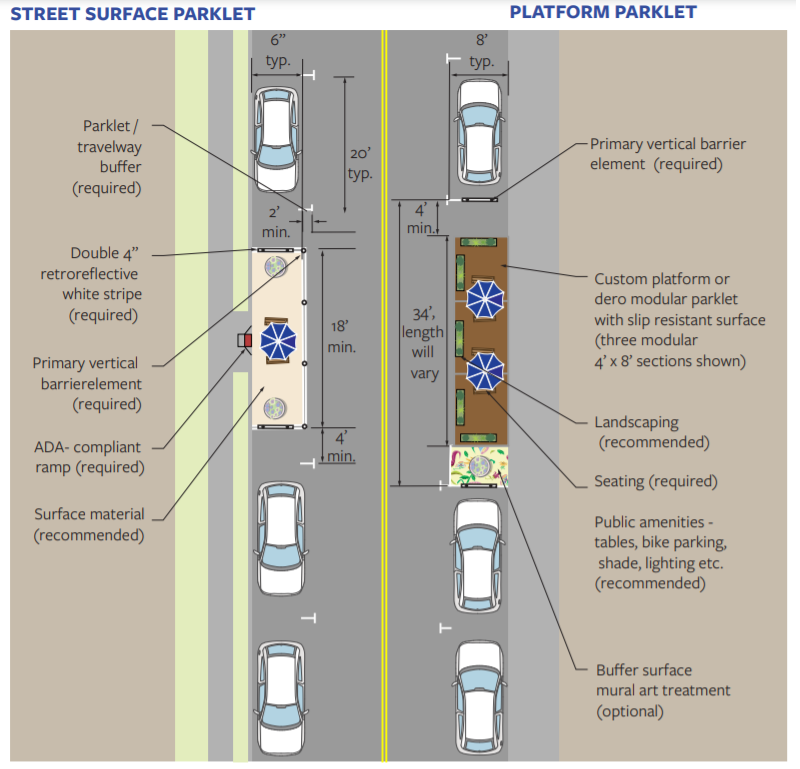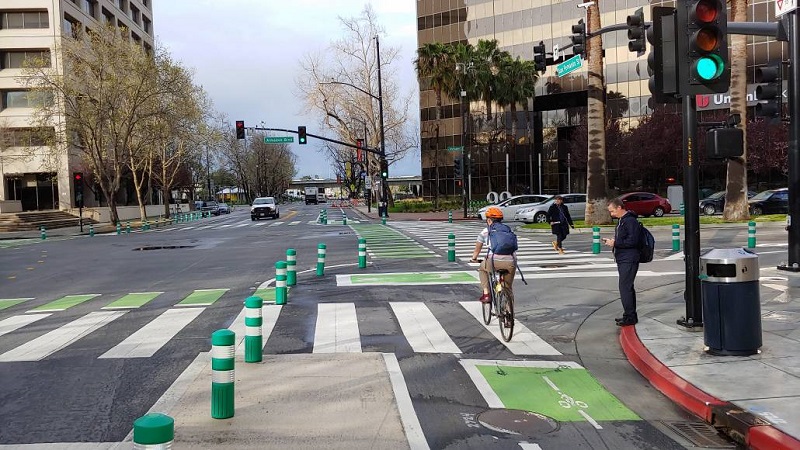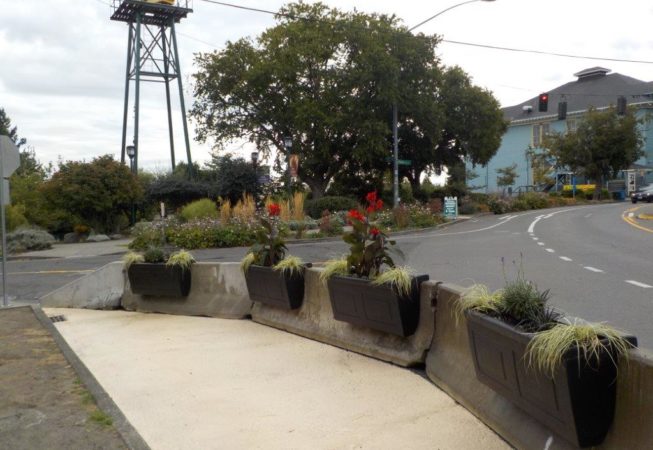Cheap and easy proofs-of-concept
It takes years for many transportation projects to go from concept to completion. But not every public works project needs such a long timeline. Some projects just need a weekend.
“Quick-Build” projects use materials such as traffic paint/tape, bollards, planters, and temporary lane delineators to change our urban landscapes. The inexpensive projects are often designed to improve roadway safety and to create open spaces for public enjoyment. These new bike lanes or small urban plazas are temporary projects to serve as a demonstration and collect data: here’s how we can transform this area – does it work, does the public like it?
There is still planning and design behind Quick-Build projects. But unlike other infrastructure projects, these Quick-Builds are implemented in days or weeks, not years. The materials are inexpensive, flexible, and temporary. And the completed project is the forum for feedback.
IMS tracks current and future projects in the transportation sector for its architectural, engineering, and consulting clients. IMS provides information through daily leads from RFPs/RFQs and in Advance Notices of upcoming projects.
IMS recently covered an RFP from the Southern California Association of Governments for a consultant to plan, promote, design, and evaluate Quick-Build projects in Pasadena, El Monte, Calexico, and Glendale. These pilot infrastructure projects would provide opportunities to test active transportation and first-/last-mile infrastructure, such as protected bike lanes, curb extensions, high-visibility crosswalks, scramble crosswalks, and cycle tracks (IMS 535561).
“Quick-Build projects allow moderate design flexibility to anticipate adjustments and immediately implement safety needs, allowing a community to benefit quickly from improvements, and to test out and provide input before they are permanently constructed,” the Association said in RFP 21-015.

Temporary street platforms are quickly being utilized by businesses to accommodate customers while adhering to COVID-19 safety regulations. (Source: Burlington, VT Quick-Build Guide)
In Vermont, the City of Burlington focused on the Quick-Build program to deliver projects that were identified in the Walk/Bike Master Plan. The Public Works Department prepared “Quick-Build Design + Material Standards” for projects that promote slow zones, greenways, placemaking, and bike/pedestrian priority corridors. Specific elements in these projects include curb extensions, mid-block pedestrian crossings, parklets, intersection murals, pedestrian plazas, bicycle lanes, and chicanes.
The city’s strategy calls for using low-cost, flexible materials to more quickly deliver street safety and placemaking projects.
“The program will provide opportunities for residents, businesses, and the City of Burlington to experience and evaluate projects before committing to long-term capital projects,” the guide said. “If a Quick-Build project is successful using the materials and design standards set forth in this Guide, then it will have the opportunity to be refined and kept in place and maintained until made more permanent with long-lasting materials. If a project is not well-received or does not achieve intended safety and accessibility outcomes, then it may be removed or altered.”
The California Bicycle Coalition has prioritized Quick-Build projects and prepared a toolkit to help cities with roadway improvements. The Coalition said projects for bicycle infrastructure can take years to go through the planning, design, approval, and construction phases. Quick-Build projects — like painting new traffic lines and installing planter boxes to create a boundary for bicycles — can be constructed in weeks.

The addition of a dedicated bike lane can be an easy and reversible Quick-Build project. (Source: CalBike)
“Quick-Build street design is literally not set in stone (or concrete), so elements can be changed in response to on-the-ground feedback,” the Coalition said. “That feedback to the actual temporary design becomes the public input process for the eventual project, if the public supports making it permanent.”
Urban planners and designers understand the need for space and safety in the era of COVID-19. Quick-Build projects can be implemented to support businesses and communities, while keeping people safe. For example, a section of Main Street can take a turn as the site of an outdoor market. Parking lots can be used for outdoor dining.
“Quick-Build is more vital than ever since the COVID-19 pandemic,” the Coalition’s toolkit said. “California cities and towns need to reallocate street space quickly to allow businesses to reopen safely, protect workers, and meet the rising demand for safe biking and walking.”
The safety theme continues with the Vision Zero campaign to eliminate traffic fatalities and serious injuries on roadways. IMS has covered hundreds of RFPs for Vision Zero design projects across the country. These are typically traffic studies, evaluations of dangerous road segments, and design services for safety improvements.
But some communities and transportation agencies are using the Quick-Build method for Vision Zero safety improvements. The City of Boulder, Colo., for example, “is dedicating $250,000 of its Vision Zero funding in 2020 to installing innovative, Quick-Build improvements on city streets in 2020 and 2021 to enhance pedestrian and bicyclist safety and comfort.”
The projects include curb extensions, pedestrian and bicyclist crossing treatments, and other traffic-calming elements.
“These Vision Zero Innovation Program projects … take a tactical urbanism approach to transportation safety, with a streamlined implementation process incorporating community feedback,” the City said.

Something as simple as concrete jersey barriers can be quickly spruced up with planter boxes to make the idea of pedestrian protection more alluring. (Source: Tactical Urbanist)
Tactical urbanism shares many of the Quick-Build principles: experimentation, short-term projects, low-cost materials, and a get-it-done attitude.
A comprehensive “Guide to Materials” with dozens of examples is available through the Tactical Urbanist’s Guide. The guide was prepared by the Street Plans Collaborative, which shows a range of tactical urbanism projects. One resource describes it as “emerging practices in transportation and street design in response to the impacts of COVID-19.”
Municipalities and transportation agencies are embracing Quick-Build as a streamlined delivery method to meet demands for safety improvements, mobility options, and public space. Some projects are well-suited to the Quick-Build process, where low-cost, flexible materials can be deployed to improve our roads and downtowns. Public feedback will determine whether the project stays or goes.

